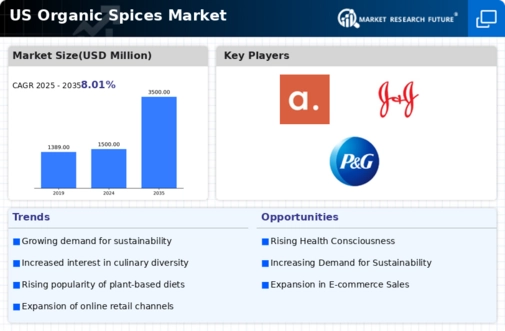The organic spices market in the US is characterized by a dynamic competitive landscape, driven by increasing consumer demand for natural and health-oriented products. Key players such as McCormick & Company (US), Frontier Co-op (US), and Simply Organic (US) are at the forefront, each adopting distinct strategies to enhance their market presence. McCormick & Company (US) focuses on innovation and product diversification, frequently launching new blends and organic options to cater to evolving consumer preferences. Frontier Co-op (US), on the other hand, emphasizes sustainability and ethical sourcing, which resonates well with environmentally conscious consumers. Simply Organic (US) leverages its strong brand identity centered around organic integrity, appealing to a niche market that prioritizes quality and transparency. Collectively, these strategies contribute to a competitive environment that is increasingly centered on quality, sustainability, and innovation.
In terms of business tactics, companies are increasingly localizing manufacturing and optimizing supply chains to enhance efficiency and reduce costs. The market structure appears moderately fragmented, with several players vying for market share, yet dominated by a few key companies that significantly influence pricing and product availability. This competitive structure allows for a diverse range of products, catering to various consumer segments while also fostering innovation as companies strive to differentiate themselves.
In October 2025, McCormick & Company (US) announced a partnership with a leading tech firm to integrate AI into its supply chain management. This strategic move is likely to enhance operational efficiency and improve demand forecasting, thereby allowing McCormick to respond more swiftly to market changes. Such technological integration may provide a competitive edge in an increasingly data-driven market.
In September 2025, Frontier Co-op (US) launched a new line of sustainably sourced spices, which underscores its commitment to environmental stewardship. This initiative not only strengthens its brand positioning but also aligns with the growing consumer preference for sustainable products. By focusing on ethical sourcing, Frontier Co-op is likely to attract a loyal customer base that values sustainability.
In August 2025, Simply Organic (US) expanded its product range to include a variety of international spices, reflecting a strategic move to tap into the growing interest in global cuisines among American consumers. This expansion may enhance its market share and appeal to a broader audience, positioning Simply Organic as a versatile player in the organic spices segment.
As of November 2025, current competitive trends indicate a strong emphasis on digitalization, sustainability, and the integration of advanced technologies such as AI. Strategic alliances are increasingly shaping the landscape, enabling companies to leverage shared resources and expertise. Looking ahead, competitive differentiation is expected to evolve, with a notable shift from price-based competition towards innovation, technology adoption, and supply chain reliability. Companies that can effectively navigate these trends are likely to secure a more robust market position.














Leave a Comment